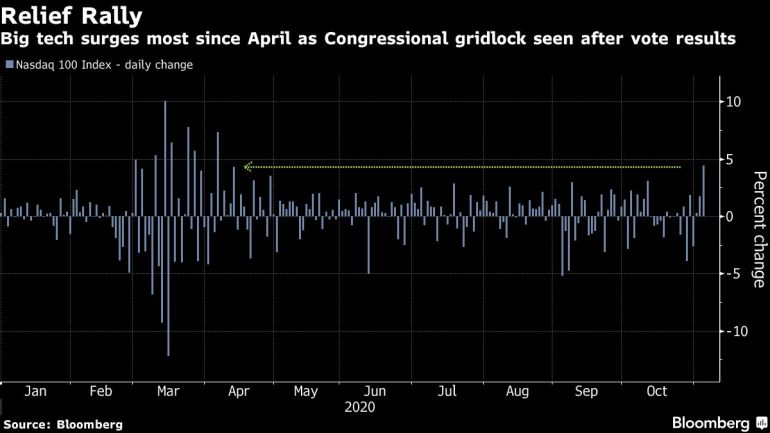Asian shares climbed on Thursday and bonds extended their blistering rally as investors wagered the likely prospect of policy gridlock in the United States would greatly favour some industries while putting a restraining hand on US government borrowing.
The risk of a prolonged, contested election remained, though the vote counting was progressing in an orderly fashion after Tuesday’s election, with Democratic challenger Joe Biden narrowly ahead in key states.
MSCI’s broadest index of Asia-Pacific shares outside Japan climbed 1.3 percent to reach its highest level since February, 2018. Japan’s Nikkei rose 1.1 percent to a nine-month top and South Korea put on 1.5 percent.
Chinese blue chips gained 0.8 percent, aided by talk that a Biden White House might ease back on President Donald Trump’s trade war tariffs.
E-Mini futures for the US’s S&P 500 share index edged up 0.1 percent, after sharp gains overnight, while the pan-European EUROSTOXX 50 futures eased 0.3 percent.
Trump and Biden have paths to 270 Electoral College votes as states tallied mail-in ballots. Biden remained optimistic on winning while the Republican incumbent filed lawsuits and demanded recounts.
Yet the prospects of the Democrats taking the Senate also dimmed, pointing to deadlock should Biden take the White House.
Taxes and tech
“A narrow win with no Senate majority means that Trump-era tax cuts may not be rolled back, at least not immediately, and fiscal stimulus, though likely, will probably be scaled back from what it would have been under a blue wave,” said Robert Carnell, Asia-Pacific head of research at Dutch bank ING.
“That means equities can rally on a reduction of tax hike fears and bond yields can fall back, which is exactly what both have done,” Carnell said in a note sent to Al Jazeera.
Analysts said such a scenario would favour technology companies, especially ones that are providing products and services to allow people to work from home during the coronavirus pandemic.
US technology and healthcare stocks duly led the charge higher overnight while those more closely tied to consumer demand lagged. With tech stocks accounting for such a large share of the indices, the S&P 500 gained 2.20 percent and the Nasdaq 3.85 percent.
 [Bloomberg]
[Bloomberg]Bond markets assumed a divided government would greatly reduce the chance of debt-funded spending on stimulus and infrastructure next year and thus less bond supply.That saw 10-year Treasury yields tumble all the way back to 0.74 percent, having touched a five-month top of 0.93 percent at one stage on Wednesday.
The overnight drop of 11 basis points was the largest single-day move since the COVID-19 market panic of March.
More liquidity?
The diminished chance of a huge US fiscal stimulus package will also pile pressure on central banks globally to inject further liquidity, just as the US Federal Reserve and Bank of England (BoE) hold policy meetings.
“Both could be interesting given the need for central banks to do more,” said Chris Beauchamp, chief market analyst at IG.
He said the Federal Reserve will have to buy more bonds – effectively printing money in a process known as quantitative easing – to provide the economy a cushion until a government stimulus package is agreed upon.
A renewed focus on Federal Reserve easing could restrain the dollar, after a wild ride overnight. The dollar index – a gauge of the greenback against a basket of other main currencies – was last at 93.433, a lot nearer Wednesday’s low of 93.070 than the high of 94.308.
Likewise, the dollar settled back to 104.30 yen having briefly been as high as 105.32 overnight. The euro held at $1.1726, well away from a low of $1.1602.
Sterling had troubles of its own after the Telegraph newspaper reported the BoE was considering lowering interest rates to below zero.
That left the pound flat at $1.2966, compared with an overnight peak of $1.3139.
All the talk of policy easing put a floor under gold prices, leaving the metal a shade firmer at $1,907 an ounce.
US crude eased back 73 cents to $38.42 a barrel, though that followed a rise of 4 percent on Wednesday, while Brent crude futures fell 79 cents to $40.44.
Credit: Source link